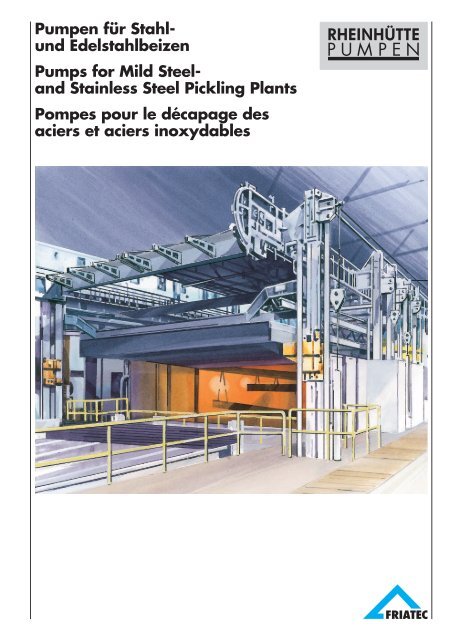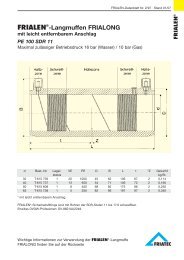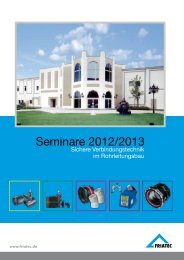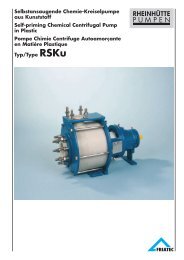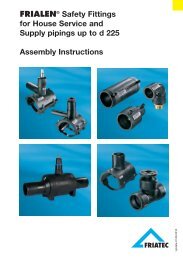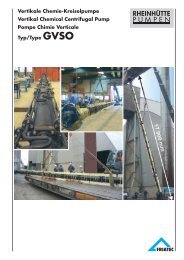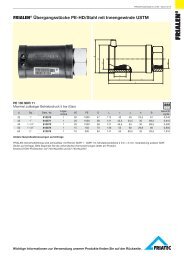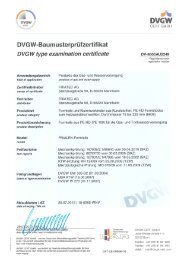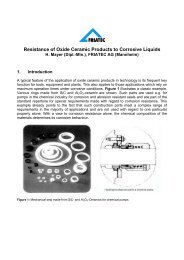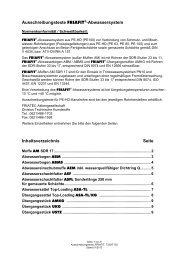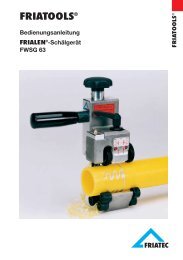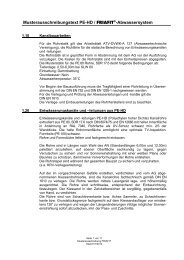Pumpen für Stahl- und Edelstahlbeizen Pumps for Mild Steel- and ...
Pumpen für Stahl- und Edelstahlbeizen Pumps for Mild Steel- and ...
Pumpen für Stahl- und Edelstahlbeizen Pumps for Mild Steel- and ...
Create successful ePaper yourself
Turn your PDF publications into a flip-book with our unique Google optimized e-Paper software.
<strong>Pumpen</strong> <strong>für</strong> <strong>Stahl</strong>-<br />
<strong>und</strong> <strong>Edelstahlbeizen</strong><br />
<strong>Pumps</strong> <strong>for</strong> <strong>Mild</strong> <strong>Steel</strong>-<br />
<strong>and</strong> Stainless <strong>Steel</strong> Pickling Plants<br />
Pompes pour le décapage des<br />
aciers et aciers inoxydables
<strong>Pumpen</strong> <strong>für</strong> <strong>Stahl</strong>- <strong>und</strong> <strong>Edelstahlbeizen</strong><br />
<strong>Pumps</strong> <strong>for</strong> mild steel- <strong>and</strong> stainless steel pickling plants<br />
Pompes pour le décapage des aciers et des aciers<br />
inoxydables<br />
Das Beizen von Metallen zwecks Korrosionsschutz<br />
wird zur Entfernung von<br />
Oberflächenschichten etwa Oxiden<br />
(z. B. Z<strong>und</strong>er, Rost), durch chemische<br />
oder elektrochemische Beh<strong>and</strong>lung<br />
durchgeführt. Dabei werden die Beizen<br />
mit metallischen Ionen <strong>und</strong> Feststoffen<br />
beladen, die eine Erneuerung der Beize,<br />
eine Abtrennung der Feststoffe oder ein<br />
Recycling der Beizflüssigkeit er<strong>for</strong>dern.<br />
Im folgenden wird auf den Einsatz von<br />
<strong>Pumpen</strong> <strong>und</strong> geeigneten <strong>Pumpen</strong>werkstoffen<br />
in der Schwefelsäurebeize, der<br />
Salzsäurebeize <strong>und</strong> der Neutralbeize<br />
eingegangen.<br />
H2SO4-Beize<br />
Die Schwefelsäurebeize war lange Zeit<br />
die wichtigste Beize zur Oberflächenbeh<strong>and</strong>lung<br />
von unlegierten Stählen. Die<br />
Konzentration der eingesetzten Schwefelsäure<br />
kann beispielsweise bei 20 %<br />
liegen, sie ist aber in den einzelnen<br />
Beizereien variabel. Die Temperatur der<br />
Beize liegt im Bereich von 60 bis 70 °C.<br />
In diesen Beizen hat sich Siguß als<br />
<strong>Pumpen</strong>werkstoff bewährt. Siguß zeigt<br />
auch in der mit Eisensulfatkristallen<br />
angereicherten verbrauchten Säure eine<br />
gute Beständigkeit. Sigußpumpen<br />
werden ebenfalls in Turmbeizen zur<br />
Beschickung der Düsen eingesetzt. Da<br />
die anfallende Eisensulfatmenge teilweise<br />
deponiert werden mußte, wurde<br />
die Möglichkeit des Einsatzes alternativer<br />
Säuren untersucht. Dies führte<br />
dann zur Entwicklung eines Beizverfahrens<br />
mit Salzsäure.<br />
HCI-Beize<br />
Die Salzsäurebeize kann aufgr<strong>und</strong> ihrer<br />
höheren Wirksamkeit bei niedrigeren<br />
Temperaturen als die Schwefelsäurebeize<br />
durchgeführt werden. Ein großer<br />
Vorteil liegt in der unaufwendigen thermischen<br />
Regenerierung der verbrauchten<br />
Salzsäure. Dabei wird nicht nur die Salzsäure<br />
zurückgewonnen, sondern auch<br />
Eisenoxid gebildet.<br />
Bei diesem Verfahren werden in Abhängigkeit<br />
von der Prozeßführung <strong>Pumpen</strong><br />
aus ultrahochmolekularem Polyethylen<br />
PE oder Polypropylen PP ggf. als Freistrompumpen<br />
vorteilhaft eingesetzt.<br />
Pickling of metals to obtain protection<br />
against corrosion <strong>and</strong> to remove<br />
<strong>und</strong>esired surface layers like oxides<br />
(<strong>for</strong> instance scales, rust) is done by<br />
chemical or electrochemical treatment.<br />
In the course of the process metal iones<br />
<strong>and</strong> solids are accumulating in the<br />
pickling solution which requires either<br />
renewal of the solution, separation of the<br />
solids or recycling of the pickling fluid.<br />
The following is dealing with the use of<br />
pumps <strong>and</strong> suitable pump materials in<br />
pickling plants run on sulphuric acid,<br />
hydrochloric acid <strong>and</strong> on neutral basis.<br />
H2SO4 Pickling<br />
Sulphuric acid pickling has been <strong>for</strong> a<br />
long time the principal method of surface<br />
treatment <strong>for</strong> plain carbon steel. The<br />
concentration of the sulphuric acid can<br />
be some 20 % but may vary from plant to<br />
plant. The temperature of the solution<br />
ranges from 60 to 70 °C. Silicon iron has<br />
proved to be fully suitable as pump<br />
material <strong>for</strong> this kind of pickling solution.<br />
It is perfectly resistant also to spent acid<br />
laden with ferrous sulphate crystals.<br />
<strong>Pumps</strong> in silicon iron are used also in<br />
pickling towers to feed the spray nozzles.<br />
Since the lot of precipitated iron sulphate<br />
had to be storaged in some cases, the<br />
possibility of employing alternative acids<br />
had been investigated. This eventually<br />
resulted in the development of a pickling<br />
process using hydrochloric acid.<br />
HCI Pickling<br />
Due to the better effectiveness of hydrochloric<br />
acid solution the process can be<br />
run at temperatures lower than necessary<br />
with the sulphuric acid process. The<br />
great advantage may be seen in the less<br />
costly thermal regeneration of spent<br />
acid. So not only acid is recovered, but<br />
iron oxide is <strong>for</strong>med also.<br />
Depending on process details pumps<br />
made of ultra-high molecular Polyethylene<br />
PE or Polypropylene PP, if<br />
necessary with recessed type impeller,<br />
are advantageously used.<br />
Le décapage des métaux dans un but<br />
de protection s’effectue par l’élimination<br />
de couches superficielles d’oxydes (par<br />
exemple calamine, rouille) par un traitement<br />
chimique ou électrochimique. Les<br />
produits de décapage sont chargés de<br />
particules solides et d’ions métalliques qui<br />
requièrent un renouvellement du décapant,<br />
une sépartion des particules solides ou un<br />
recyclage du bain de décapage.<br />
Les paragraphes ci-dessous abordent<br />
l’utilisation des pompes et des matériaux<br />
appropriés dans les décapants à base<br />
d’acide sulfurique, d’acide chlorydrique<br />
ou neutres.<br />
Décapants à base d’acide sulfurique<br />
H2SO4<br />
Les décapants à base d’acide sulfurique<br />
ont été pendant longtemps les décapants<br />
les plus importants pour le traitement superficiel<br />
d’aciers non alliés. La concentration<br />
d’acide peut être par exemple d’environ<br />
20 % mais est variable suivant les installations<br />
décapage. La température du décapant<br />
est de 60 à 70 °C.<br />
La fonte au silicium a fait la preuve de ses<br />
qualités en tant que matériau de pompe<br />
pour les bains de décapage. La fonte au<br />
silicium possède également une bonne résistance<br />
aux acides enrichis de cristaux de<br />
sulfate de fer. Les pompes en fonte au silicium<br />
sont également employées dans les<br />
tours de décapage pour l’alimentation des<br />
injecteurs. Etant donné que la quantité de<br />
sulfate de fer produite doit en partie être<br />
déposée, on étudie alors la possibilité<br />
d’utiliser d’autres acides. Cela a abouti au<br />
développement d’un procédé de décapage<br />
à base d’acide chlorhydrique.<br />
Décapants à base d’acide<br />
chlorhydrique (HCI)<br />
Les décapants à base d’acide chlorhydrique,<br />
par suite de leur gr<strong>and</strong>e efficacité<br />
à basse température peuvent être utilisés<br />
à la place des décapants à base d’acide<br />
sulfurique. Un gr<strong>and</strong> avantage réside<br />
dans le fait qu’il n’est pas nécessaire de<br />
régénérer thermiquement l’acide chlorhydrique<br />
utilisé. Ainsi, non seulement on récupère<br />
de d’acide chlorhydrique, mais il<br />
se <strong>for</strong>me également de l’oxyde de fer.<br />
Dans ce procédé, sont utilisées avantageusement<br />
des pompes en polyéthylène<br />
(PE) à haut poids moléculaire ou en<br />
polypropylène (PP) ou les cas échéant,<br />
des pompes à vortex.<br />
2
Vereinfachtes Verfahrensfließbild einer<br />
HCI-Beize<br />
3<br />
H2O<br />
Vorratsbehälter<br />
storage tank<br />
Réservoir de stockage<br />
Neutralbeize<br />
Absorber<br />
absorber<br />
Absorbeur<br />
Bei Neutral- oder auch Natriumsulfatbeize<br />
h<strong>and</strong>elt es sich um ein elektrochemisches<br />
Beizverfahren. Dabei<br />
werden keine Säuren eingesetzt, sondern<br />
eine wäßrige Na2SO4-Lösung. Die<br />
Entfernung der Oberflächenschichten<br />
wird durch ständig wechselnde<br />
anodische <strong>und</strong> kathodische Belastung<br />
des Metalles erreicht. Hier sorgt die<br />
Gasentwicklung <strong>für</strong> das Abplatzen der<br />
Oxidschicht. Die Neutralbeize wird<br />
hauptsächlich zum Beizen von chromlegierten<br />
Stählen verwendet.<br />
Simplified flow diagram of an HCl pickling<br />
plant<br />
HCI-Gas<br />
HCI gas<br />
Gaz HCI<br />
Frischsäure<br />
fresh acid<br />
Acide frais<br />
Neutral Pickling<br />
Röstofen<br />
roasting<br />
furnace<br />
Four de<br />
calcination<br />
Fe2O3<br />
Neutral pickling, also called sodium<br />
sulphate pickling, is an electrochemical<br />
process. It uses an aqueous Na2SO4<br />
solution instead of acids. Removal of<br />
the surface layers is achieved by<br />
permanently alternating anodic <strong>and</strong><br />
cathodic loadings acting on the metal.<br />
Here the development <strong>and</strong> the action of<br />
gas bubbles cause flaking off of the<br />
oxide skin. Neutral pickling is mainly<br />
used to treat chromium-alloyed steel.<br />
Schéma simplifié d’un procédé de décapage<br />
à base d’acide chlorhydrique<br />
Décapant neutre<br />
Blech<br />
sheet<br />
Tôle<br />
Verbrauchte Säure<br />
spent acid<br />
Acide usé<br />
Dans le décapage neutre ou à base de<br />
sulfate de sodium, il s’agit d’un procédé<br />
électrochimique de décapage. Aucun<br />
acide n’est employé. Il s’agit d’une solution<br />
aqueuse de Na2SO4. L’élimination<br />
des couches superficielles est obtenue<br />
par le changement permanent de la<br />
charge anodique et cathodique du métal.<br />
Le développement du gaz aboutit à<br />
l’éclatement de la couche d’oxyde. Le<br />
décapant neutre est principalement<br />
utilisé pour le décapage d’aciers alliés<br />
au chrome.
In Abhängigkeit vom vorliegenden Beanspruchungskollektiv<br />
(pH-Wert, Feststoffgehalt<br />
der Lösung u. a.) eignen sich als<br />
<strong>Pumpen</strong>werkstoffe 1.4408, Siguß, die<br />
chromlegierte Siliziumgußlegierung<br />
Sicro5 oder der Halbaustenit HA28.5.<br />
Unter bestimmten Voraussetzungen<br />
bietet sich auch der Einsatz von <strong>Pumpen</strong><br />
aus PP oder PE an. Bei Blechen ist nach<br />
der Neutralbeize oft noch eine Nachbeize<br />
in einer Salpetersäure-Flußsäurebeizlösung<br />
er<strong>for</strong>derlich, um eine homogene<br />
Oberlächenbeschaffenheit zu<br />
erzielen.<br />
Im Bereich der Förderung von Beizflüssigkeiten<br />
besitzt die FRIATEC-Rheinhütte<br />
umfangreiche praktische Erfahrungen,<br />
die zusätzlich auf Ergebnisse eigener<br />
Untersuchungen gestützt sind. Daher<br />
haben wir die Kompetenz erworben den<br />
optimalen <strong>Pumpen</strong>werkstoff auch <strong>für</strong><br />
schwierige Medien herauszufinden.<br />
FRIATEC-Rheinhütte-<strong>Pumpen</strong>baureihen<br />
<strong>für</strong> Beizanlagen<br />
4<br />
In dependence on prevailing operating<br />
<strong>and</strong> fluid details (pH value, contents of<br />
solids in the solution, etc.) the pumps<br />
can be made of the following materials:<br />
1.4408 (18/10/2) stainless steel, silicon<br />
iron, Sicro5 silicon iron alloyed with<br />
chromium or HA 28.5 semi-austenitic<br />
stainless steel. <strong>Pumps</strong> in PP or PE can<br />
be used <strong>und</strong>er certain conditions also.<br />
After neutral pickling of sheets often a<br />
repickling in a nitric/hydrofluoric bath<br />
turns out to be necessary to achieve a<br />
homogenous, smooth surface.<br />
FRIATEC-Rheinhütte has wide experience<br />
in the field of h<strong>and</strong>ling pickling<br />
fluids, gained by practical activities in<br />
operative plants, additionally backed-up<br />
by laboratory research. So we claim to<br />
be able to find the most suitable material<br />
of construction <strong>for</strong> pumps, even <strong>for</strong> tough<br />
fluids.<br />
FRIATEC-Rheinhütte <strong>Pumps</strong> used<br />
in Pickling Plants<br />
<strong>Pumpen</strong>typ Werkstoffe<br />
Type of Pump Materials<br />
Type de Pompe Matériaux<br />
Chemie Normpumpe Typ Polypropylen PP<br />
St<strong>and</strong>ardized Chemical <strong>Pumps</strong> Type CPDR RCNKu Polypropylene PP<br />
Pompes Chimie Normalisées Type<br />
Vertikale Chemie-Kreiselpumpen Typ Polyethylen PE<br />
Vertical Chemical <strong>Pumps</strong> Type RKuV RVKu Polyethylene PE<br />
Pompes Chimie Verticales Type<br />
En fonction des exigences existantes<br />
(valeur pH, particules solides dans la<br />
solution) les matériaux 1.4408 (Z 6 CND<br />
18.11), fonte au silicium, fonte au silicium<br />
alliée au chrome Sicro 5, ou l’alliage<br />
semi-austénitique HA 28.5 conviennent.<br />
Sous certaines conditions il est possible<br />
d’utiliser des pompes en PP ou en PE.<br />
Pour les toles, il est souvent nécessaire<br />
après le décapage neutre, d’appliquer un<br />
décapage complémentaire dans une<br />
solution d’acide nitrique, acide fluorhydrique<br />
afin d’obtenir un état de surface<br />
homogène.<br />
Dans le domaine du pompage de liquides<br />
de décapage, FRIATEC-Rheinhütte<br />
possède une gr<strong>and</strong>e expérience pratique<br />
basée sur les résultats de ses propres<br />
recherches.<br />
Nous avons ainsi acquis une gr<strong>and</strong>e<br />
compétence pour déterminer le meilleur<br />
matériau de pompe y compris pour les<br />
produits très agressifs.<br />
Gamme de pompes<br />
FRIATEC Rheinhütte pour les<br />
installations de décapage<br />
Chemie-Normpumpen Typ Eisensiliziumlegierungen / Silicon<br />
St<strong>and</strong>ardized Chemical <strong>Pumps</strong> Type RN RNSi iron alloys / Alliages ferro-silicium:<br />
Pompes Chimie Normalisées Type Siguß, Sicro 5<br />
Chemiepumpen Typ Halbaustenit / semi-austenitic/<br />
Chemical <strong>Pumps</strong> Type RCE Semi-austénite: HA 28.5<br />
Pompes Chimie Type Austenit 1.4408
RNSi..B<br />
CPDR..CS<br />
● Stationäre Gleitringdichtung; offenes Laufrad mit Rückenschaufeln,<br />
mediumberührte Teile aus massivem Kunststoff;<br />
robuste Vollpanzerung aus GGG 40. In Abhängigkeit des<br />
Fördermediums kann die Pumpe auch mit Quench oder<br />
Spülanschluß geliefert werden.<br />
● Stationary mechanical shaft seal; semi-open impeller with<br />
back vanes; parts in contact with fluid made of solid plastic<br />
material; sturdy armour in ductile cast iron GGG 40. Depending<br />
on fluid h<strong>and</strong>led pump can be provided with quench or<br />
flush connection.<br />
● Garniture mécanique stationnaire; turbine semi-ouverte<br />
avec ailettes dorsales; pièces en contact avec le liquide en<br />
matière plastique massive; blindage robuste on fonte à graphite<br />
sphéroïdale FGS 400. En fonction du liquide la pompe<br />
peut être livrée avec quench ou raccord de rinçage.<br />
RCNKu..CSA<br />
RCNKu..CSA<br />
● Stationäre Gleitringdichtung; konisch erweiterter Dichtungsraum<br />
<strong>für</strong> feststoffhaltige Medien; geschlossenes Laufrad; mediumberührte<br />
Teile aus massivem Kunststoff; robuste Vollpanzerung<br />
aus GGG 40. Quench oder Spülanschluß möglich.<br />
● Stationary mechanical shaft seal; conically shaped seal<br />
insert <strong>for</strong> fluids containing solids; closed impeller; parts in<br />
contact with fluid made of solid plastic material; sturdy armour<br />
in ductile cast iron GGG 40. Quench or flush connection<br />
available on request.<br />
● Garniture mécanique stationnaire; flasque de garniture<br />
avec dégagement conique pour le pompage de liquides<br />
chargés; turbine fermée; pièces en contact avec le liquide en<br />
matière plastique massive; blindage robuste on fonte à<br />
graphite sphéroïdale FGS 400. Possibilité de quench ou de<br />
raccord de rinçage.<br />
5<br />
RNSi..B<br />
● Hydrodynamische Wellenabdichtung; entlastete Stopfbuchspackung;<br />
keine Spül- <strong>und</strong> Sperrflüssigkeit er<strong>for</strong>derlich;<br />
Betriebstemperaturen bis 300 °C; korrosions- <strong>und</strong> verschleißfester<br />
<strong>Pumpen</strong>werkstoff.<br />
● Hydrodynamic shaft sealing, not sensitive to solid impurities<br />
<strong>and</strong> there<strong>for</strong>e minimal wear; relieved stuffing box packing;<br />
quench <strong>and</strong> seal liquids not necessary: operating temperature<br />
up to 300 °C; corrosion- <strong>and</strong> wear resistant pump material.<br />
● Etanchéite d’arbre hydrodynamique, convient pour liquides<br />
chargés avec une usure minime; presse-étoupe déchargé; ne<br />
nécessite pas de fluide de rinçage ni de blocage; température<br />
de service jusqu’à 300 °C; matériaux de pompe résistant à la<br />
corrosion et à l’abrasion.<br />
RKuV<br />
● Kein Gleitlager im<br />
Fördergut; weit ausein<strong>and</strong>ergezogene<br />
Wälzlager; offenes<br />
Laufrad oder Freistromrad;<br />
druckentlasteter Wellendurchtritt;<br />
Labyrinth- oder Lippenabdichtung;<br />
Tauchtiefe maximal<br />
1.5 m, kann durch<br />
Anfügen eines Saugrohres<br />
vergrößert werden.<br />
● No submerged sleeve<br />
bearing (cantilever design);<br />
large span between antifriction<br />
bearings; semiopen or<br />
recessed type impeller;<br />
pressure relieved shaft gl<strong>and</strong>;<br />
labyrinth or lip-seal, maximum<br />
pump length 1.5 m, can be<br />
extended by attaching a<br />
suction pipe.<br />
● Pas de palier dans le<br />
liquide pompé; écartement<br />
important des roulements;<br />
turbine ouverte ou à vortex;<br />
passage d’arbre déchargé;<br />
étanchéité avec joint à labyrinthe<br />
ou à lèvres; les hauteurs<br />
de suspension jusqu’à<br />
1,5 m peuvent être augmentées<br />
par l’adjonction d’un tube<br />
d’aspiration.<br />
CPDR..CS<br />
RKuV
3.00.0011 – 1002 d-e-f<br />
FRIATEC-Rheinhütte GmbH & Co.<br />
Postfach / P.O.B. 12 05 45 • D-65083 Wiesbaden<br />
Rheingaustr. 96 -100 • D-65203 Wiesbaden<br />
Tel. +49 (0)611/604-0 • Fax +49 (0)611/604-328<br />
Internet: www.friatec.de • www.rheinhuette.de<br />
e-mail: info@rheinhuette.de • service@rheinhuette.de<br />
05 · 10.02 WST


